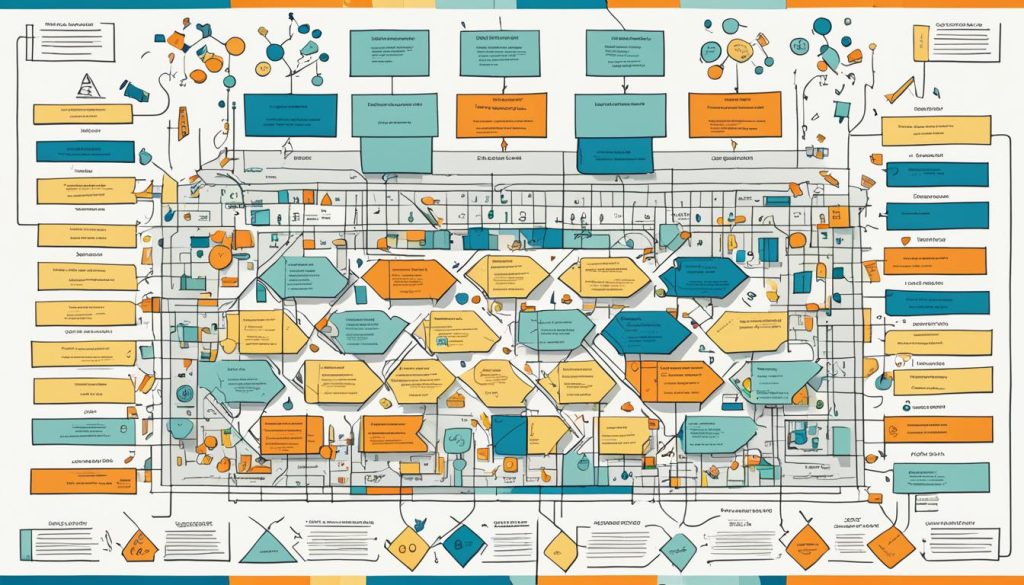If you’re looking to secure your family’s future, you might have heard about 529 plans. These are special savings accounts that help fund education costs. They have great benefits, but they also have risks that are often missed. This guide will cover the history of 529 plans, their complexities, and how they affect financial aid and investments. We’ll also talk about the risks and how to make the most of these plans in your financial plan.
Key Takeaways
- Learn how 529 plans started as a tax-friendly way to save for school.
- See the details of 529 plans, like investment choices, fees, and how you can take money out.
- Find out how 529 plans affect your chances for financial aid and how to use them to your advantage.
- Discover ways to balance risk and return in your 529 plan investments.
- Learn about the hidden risks of 529 plans, like state limits and tax effects.
- Improve your 529 plan use within your financial plan for long-term success.
- Keep up with the latest in 529 plans and their changes.
- https://tunekong.com/outdoor-lighting-ideas-to-illuminate-your-nights-and-enhance-your-space-7/
The Evolution of 529 Plans
Tracing the Origins and Development of College Savings Plans
529 plans started in 1996 as state-sponsored, tax-advantaged accounts1. Over time, they’ve grown to offer more flexibility and investment choices for college-bound families2. These plans let money grow without taxes, and withdrawals are tax-free for education costs. This makes them a top choice for saving for college.
Initially, 30 states launched their 529 plans from 1996 to 20002. Now, all 49 states and the District of Columbia offer them, giving families many options2. The rise in 529 plans matches the growing cost of college, with tuition going up by two to three times inflation each year for the last 40 years2.
529 plans are popular because of their tax benefits. The 2001 tax act made their earnings tax-free, making them more appealing for education savings2. Over twelve million families have saved more than $258 billion in 529 plans, and over two million students have used them for college2.
Even with rising college costs and more student loans, 529 plans help parents save for college2. As college financing changes, 529 plans are key for many families’ financial plans for their kids’ future.
| Key Highlights | Data |
|---|---|
| National 529 College Savings Day | May 29th1 |
| Texas College Savings Plans | Open for enrollment year-round1 |
| Texas Tuition Promise Fund | Open for newborn enrollment through July, reopen for general enrollment on Sept. 11 |
| Texas College Savings Plan Assets | $2.5 billion, serving over 260,000 Texans1 |
| Average Cost of Public 4-Year College | $11,260 for in-state tuition in 2023-241 |
| Average Cost of Private College | $41,540 for one academic year in 2023-241 |
“529 plans have been successful in motivating parents to invest and save for their child’s higher education expenses.”
Navigating the Complexities of 529 Plans
Starting to save for your child’s education means diving into the world of 529 plans. These accounts offer tax benefits but have rules you need to know. It’s important to understand how they work, from how much you can put in to how you can take money out. Knowing these details helps you use the plan well and avoid mistakes.
When looking at 529 plans, think about how much you can put in. Each state sets its own limits on how much you can add each year or over time3. Some states also give tax breaks for putting money into these plans, making them more appealing4.
How you can take money out of a 529 plan is also key. The money is for school costs like tuition and books. Taking it out for other reasons can lead to extra fees and taxes4.
| 529 Plan Feature | Explanation |
|---|---|
| Contribution Limits | Each state sets its own guidelines on the maximum amount that can be contributed annually or over the lifetime of the account3. |
| Tax Deductions and Credits | Some states offer tax deductions or credits for contributions to 529 plans, providing an additional incentive to invest in these accounts4. |
| Withdrawal Requirements | Funds from 529 plans must be used for qualified educational expenses, such as tuition, fees, and textbooks. Withdrawals for non-educational purposes may result in penalties and tax implications4. |
| State-Specific Plan Features | Each state’s 529 plan has unique rules and regulations affecting contributions, deductions, investment options, and other aspects of the account4. |
It’s important to know the special rules of your state’s 529 plan. Each state has its own rules about how much you can put in, what fees there are, and even tax benefits4. Understanding these can help you make the best choices for your savings.
Learning about 529 plan rules helps you make smart decisions for saving for college. Whether you’re just starting or have been saving for a while, keeping up with changes can help you reach your goals34.

“Investing in a 529 plan early and consistently can be a powerful tool in securing your child’s educational future.”
529 Plans and Financial Aid Implications
Understanding how 529 plans affect your financial aid is key when planning for college costs. Savings in a 529 plan aren’t invisible to the FAFSA5. They can actually change how much need-based aid your child gets.
529 plans affect your aid package when reported on the FAFSA. Parent-owned 529 plans count as an asset and can cut your aid by up to 5.64% of the plan’s value5. But, the first $10,000 is protected from aid calculations6. Student-owned plans are assessed at a 20% rate5.
Grandparents’ 529 plans have changed too. Before, withdrawals were seen as income on the FAFSA, hurting aid chances7. But, starting in 2024-25, these withdrawals won’t count as income5. This change helps families save for college without hurting aid chances.
| Asset Type | Impact on Financial Aid |
|---|---|
| Parental 529 Plan | Up to 5.64% of plan value reduces aid package |
| Student-Owned 529 Plan | 20% of asset value reduces aid package |
| Grandparent-Owned 529 Plan (pre-2024) | Withdrawals considered untaxed income, negatively impacting aid |
| Grandparent-Owned 529 Plan (post-2024) | Withdrawals no longer considered untaxed income |
529 plans affect aid more than just asset reporting. Families need to know the difference between need-based and merit-based aid7. Need-based aid can be affected, but merit-based aid isn’t usually impacted.
Knowing how 529 plans work with financial aid helps families plan better. Early planning and using tools like the FAFSA can make a big difference. This way, families can save more for college and reduce student loans7.
“Families must be aware of the potential impact of 529 plans on their financial aid situation and strategize accordingly.”
Investing Strategies within 529 Plans
When looking at 529 plan investment options, families have many choices. They can pick from aggressive growth to conservative fixed-income options8. It’s important to think about how much risk you can handle, how long until you need the money, and your child’s age. This helps pick the best investment strategy for saving for college8.
Balancing Risk and Return in College Savings
It’s key to balance risk and return when investing in a 529 plan9. In 2020-21, the cost for public in-state college was $26,820 a year. For private college, it was $54,880 a year9. With college costs going up, making sure your 529 plan is ready for these costs is crucial.
529 plans offer different investment strategies, like age-based and objective-based asset allocation, and customized options10. You can pick from conservative, moderate, or aggressive portfolios and change them twice a year10. As your child gets older, it’s smart to make your investments more conservative to protect your college savings10.
| Asset Allocation by Child’s Age | Stocks | Bonds | Short-Term Reserves |
|---|---|---|---|
| 0-4 years old | 62.5% | 37.5% | – |
| 5-6 years old | 50% | 50% | – |
| 7-8 years old | 37.5% | 62.5% | – |
| 9-10 years old | 25% | 75% | – |
| 11-12 years old | 12.5% | 87.5% | – |
| 13-14 years old | – | 75% | 25% |
| 15-16 years old | – | 50% | 50% |
| 17-18 years old | – | 25% | 75% |
| 19 and higher | – | – | 100% |
When picking a 529 plan, think about tax benefits, investment strategy, fees, and how easy it is to get information8. Tools like Savingforcollege.com and Vanguard’s 529 plan comparison tool can help parents find the best plan for their college savings strategies8.

“Balancing risk and return is crucial to ensure the portfolio is well-positioned to meet the ever-increasing costs of higher education.”
529 Plans: Revealing the Hidden Risks
529 plans are great for saving for college because they offer tax benefits. But, they also have risks that families should think about. One big risk is that they might not grow as much as expected11. They tend to be safe, which means they might not make as much money11. Also, the costs for 529 plans can change a lot by state, so it’s important to check these costs11.
Another thing to watch out for is how different states limit 529 plans. Some states let you save a lot, up to $300,000 or more11. But, others have stricter rules. Also, taking money out of a 529 plan before age 59 and a half can lead to big penalties and taxes11.
Even with these risks, 529 plans can be a good way to save for college, especially if you start early. Over time, your money can grow a lot11. But, you need to look into your state’s plan, the investment choices, and the costs11. Making regular payments, picking investments that fit your risk level, and checking and changing your plan as needed are key to managing your 529 plan well11.
| Key 529 Plan Risks | Potential Impact |
|---|---|
| Investment Underperformance | Over $300,000 contribution limits in some states, allowing for significant savings11 |
| High Fees and Expenses | 10% penalty plus income tax on non-qualified withdrawals before age 59 and a half11 |
| State-Specific Limitations | Some states offer state income tax deductions or credits for contributing11 |
| Complex Tax Implications | Management fees are charged by fund companies, typically reasonable11 |
In conclusion, 529 plans have great tax benefits, but families need to think about the risks and limits. By understanding and dealing with these risks, families can make the most of 529 plans. This way, they can plan better for their kids’ education11.
Optimizing 529 Plans for Your Financial Strategy
Maximizing the Benefits of College Savings Plans
To make the most of your 529 plan, blend it with other savings options like Roth IRAs and taxable accounts. This approach helps create a tax-smart and varied way to fund your child’s education12.
Think about how to use your 529 plan to save on taxes. Thirty-four states and the District of Columbia offer tax breaks for 529 plan contributions12. Seven states also give benefits for any 529 plan, not just their own12. Using these state perks can boost the tax benefits of your 529 plan.
Choosing the right investments is key. Savingforcollege.com gives each 529 plan a 5-Cap Rating based on its past performance, costs, features, and reliability12. By looking at these ratings and matching your investments with your risk level and goals, you can make a smart college savings plan.
Adding credit card rewards to your 529 plan can be smart, but remember to pay off the card each month to avoid extra charges12. This way, you can grow your college savings without extra costs.
Seeing your 529 plan as part of your long-term financial plan is crucial. By combining it with other savings, using tax perks, and balancing risk and return, you can make sure your college savings are effective and fit your financial goals1213.
| Key Considerations | Recommendations |
|---|---|
| Tax Benefits | |
| Investment Selection | |
| Credit Card Rewards |
|
“Integrating your 529 plan with your broader financial strategy is key to maximizing the benefits of college savings.”
By using these strategies, you can make your 529 plan work better for your long-term goals. This ensures your college savings are doing their best for you and your family121314.
Conclusion
529 plans are key for families saving up for college costs. Even though only 18% of kids have a 529 account15, there’s a chance for more with a catchy name and more awareness15. These plans offer tax-free earnings, state tax breaks, and high limits, making them great for saving for college15.
The 529 plan world is changing, and families need to understand it to get the most benefits and avoid risks. Total assets in these plans have grown by 16% to $441 billion, and the average age of the beneficiaries is now 14.5 years old16. By learning about investment strategies, how they affect financial aid, and the different state plans, families can save better for college and secure their kids’ future.
529 plans are a strong way to plan for college costs15. Their value comes from using strategies that fit your family’s needs and goals. This article’s insights can help you make smart choices. Make sure your 529 plan is a key part of your financial plan.
FAQ
What are 529 plans and how do they work?
529 plans help families save for college costs. They are special savings accounts that grow without taxes. When you use the money for school, it’s tax-free.
How have 529 plans evolved over the years?
Since 1996, 529 plans have changed a lot. They now offer more investment choices to help families save for college. This change helps families deal with the rising cost of college.
What are the key factors to consider when navigating 529 plan complexities?
When using 529 plans, think about how much you can put in, how you can take money out, and what your state offers. Knowing these details is key to getting the most from your plan and avoiding problems.
How can 529 plans impact a student’s financial aid eligibility?
529 plans can affect how much financial aid a student gets. The way they’re reported on the FAFSA can change the amount of aid. Families should plan carefully to understand this impact.
What investment strategies should be considered within 529 plans?
529 plans offer different investment options, from risky to safe. Families should think about how much risk they can handle, how long until college, and their child’s age. This helps pick the right investment strategy for college costs.
What are the hidden risks associated with 529 plans?
529 plans have benefits but also risks. These include bad investments, high fees, state limits, and tax issues. Knowing these risks helps families make smart choices for saving for college.
How can families optimize their 529 plans within their broader financial strategy?
To get the most from 529 plans, link them with other savings like Roth IRAs and taxable accounts. This creates a plan that’s tax-smart and covers all college costs. By doing this, families can use 529 plans well and meet their financial goals.

